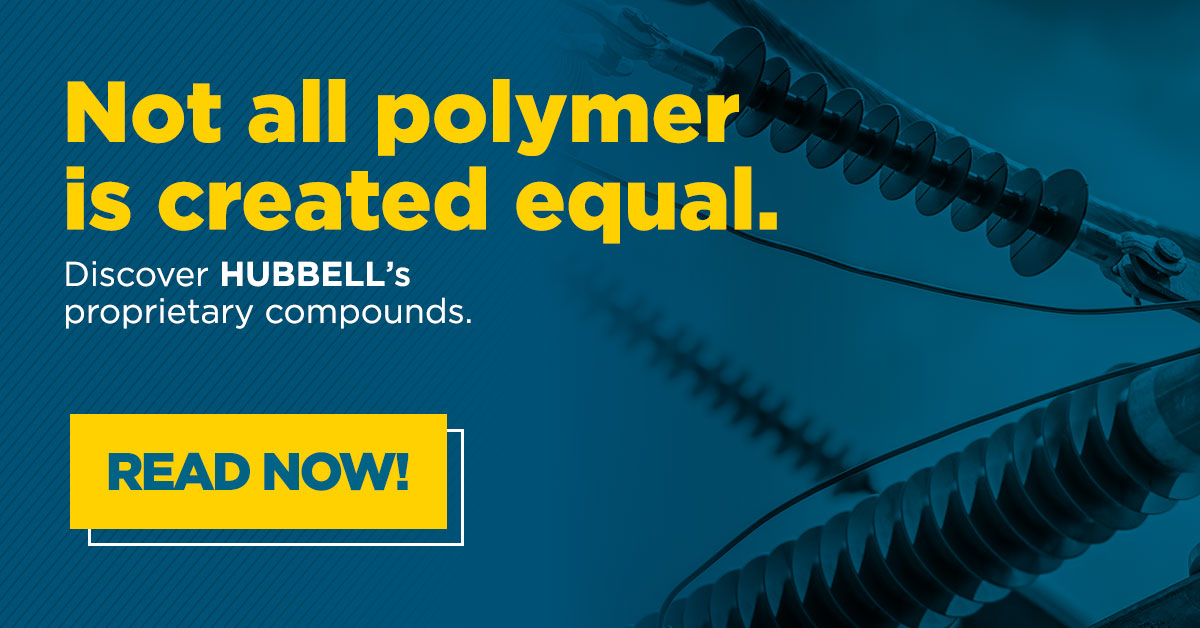Polymer compounding for utility electrical equipment is a complex subject. Too often, insulators are dismissed as commodity products. The perception that the base polymer alone defines all product characteristics is mistaken. Nothing could be further from the truth. Materials (including additives and fillers) and design impact performance.
Today we want to give you some background and introduce our two proprietary polymer compounds:
This series will give you a solid understanding of polymer compounds for high voltage insulators. The information will help you choose the best material and design for your application.
Background Experience in Polymer Insulators
Hubbell’s long history of innovation has played an important role in the development of high-voltage insulators. In the late 1880s, the Ohio Brass company was founded about the same time as Hubbell Incorporated.
Ohio Brass was a leader in the porcelain insulator industry, patenting the original cap and pin porcelain insulator design still commonly used today. Our porcelain bell insulators were used in the first high voltage transmission line in North America, at Niagara Falls in 1905.
In the 1960s, the industry was investigating polymer compounds as an effective alternate material for insulators to support the expanding power grid. Polymer materials offer a viable alternative to porcelain for several reasons:
- weight savings
- improved performance in contaminated environments
- added safety
- increased design versatility
By the time Ohio Brass became part of the Hubbell family in 1978, we had been researching polymer technology for almost 14 years. The success of our early Hubbell polymer insulators helped fuel the growth of the market segment.
A Tale of Two Polymers
The result of almost 60 years’ experience of successful development, testing, and field deployment has been the creation of two proprietary polymers for high-voltage insulators. These offer you different feature characteristics that deliver superior performance in the harshest environments. For a quick overview, see our comparison page.
 Our proprietary silicone rubber is compounded with a 100% silicone base. Silicone provides excellent hydrophobicity (the ability to repel water) and UV resistance to the insulator. However, more is required to protect an insulator throughout its life. Additional components are needed in the compound to deliver other characteristics. These include superior tracking resistance and corona resistance—ours is 10X greater than typical silicone compounds.
Our proprietary silicone rubber is compounded with a 100% silicone base. Silicone provides excellent hydrophobicity (the ability to repel water) and UV resistance to the insulator. However, more is required to protect an insulator throughout its life. Additional components are needed in the compound to deliver other characteristics. These include superior tracking resistance and corona resistance—ours is 10X greater than typical silicone compounds.
Combined with effective insulator designs, these characteristics of our silicone rubber extend the life of the insulator and combat the damaging environment of high voltage insulator applications.
.jpg?width=200&height=200&name=HUS-MULTI-GR-EN-02720_ESP_social-post-9%20(1).jpg) Our proprietary ESP™ enhanced silicone polymer is a blend of silicone base and ethylene propylene diene monomer (EPDM). A key benefit is its greater mechanical strength and durability. ESP polymer offers 3X more tear strength than commonly available silicone polymers. Along with excellent tracking resistance and hydrophobicity, it provides exceptional UV resistance--lasting over 8X longer than ASTM test requirements. ESP material is also bird and rodent resistant, making it perfect for applications where animal contact may be a concern.
Our proprietary ESP™ enhanced silicone polymer is a blend of silicone base and ethylene propylene diene monomer (EPDM). A key benefit is its greater mechanical strength and durability. ESP polymer offers 3X more tear strength than commonly available silicone polymers. Along with excellent tracking resistance and hydrophobicity, it provides exceptional UV resistance--lasting over 8X longer than ASTM test requirements. ESP material is also bird and rodent resistant, making it perfect for applications where animal contact may be a concern.
Both exclusive polymers provide high reliability and long-term durability that critical high voltage insulator applications require. Hubbell offers an extensive line of polymer insulators for both transmission and distribution voltages.
Next: Get an Inside Look at Compounding
Not all polymers are the same. Hubbell’s compounding and design experience deliver performance and options beyond meeting the required standards for utilities worldwide. Read the blog post now.

.jpg?width=200&height=200&name=HUS-MULTI-GR-EN-02720_ESP_social-post-9%20(1).jpg)


